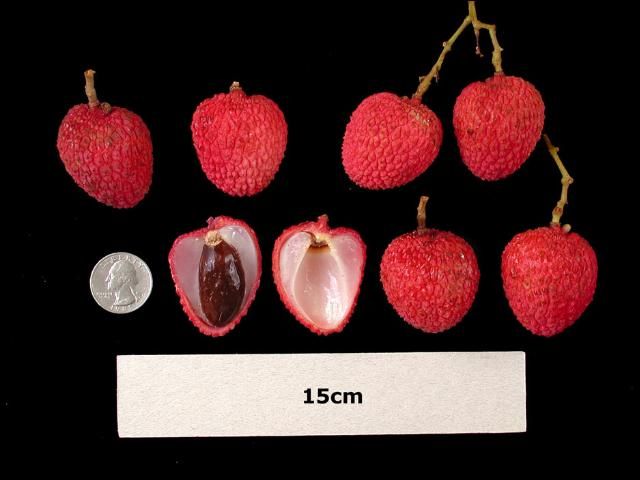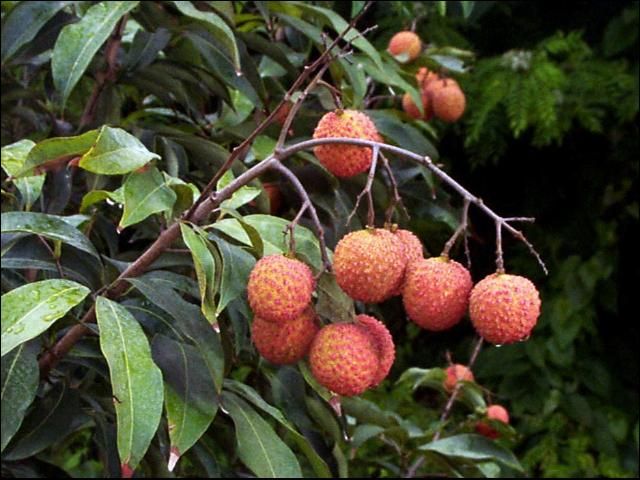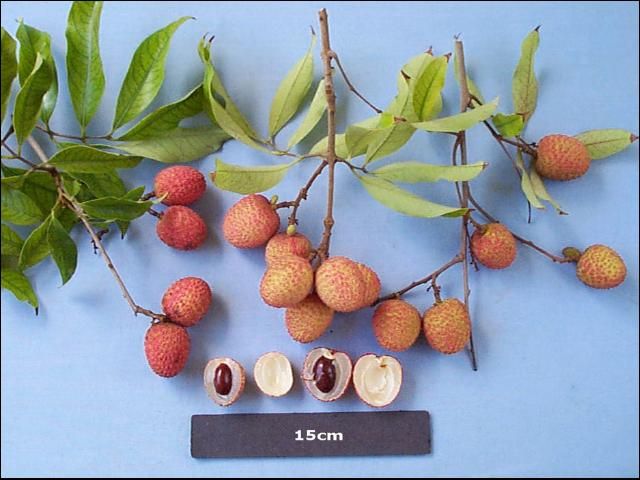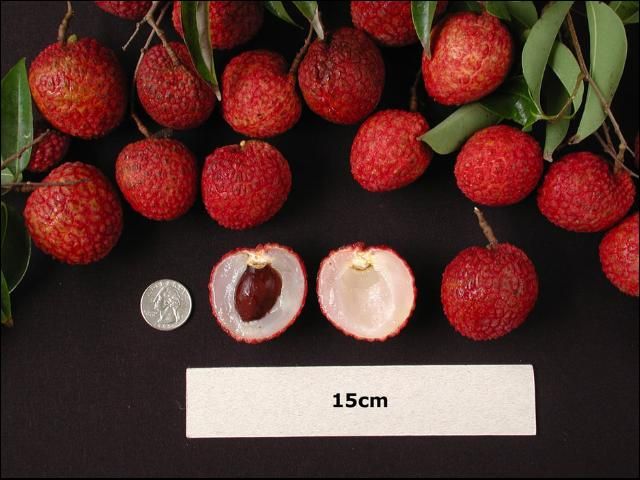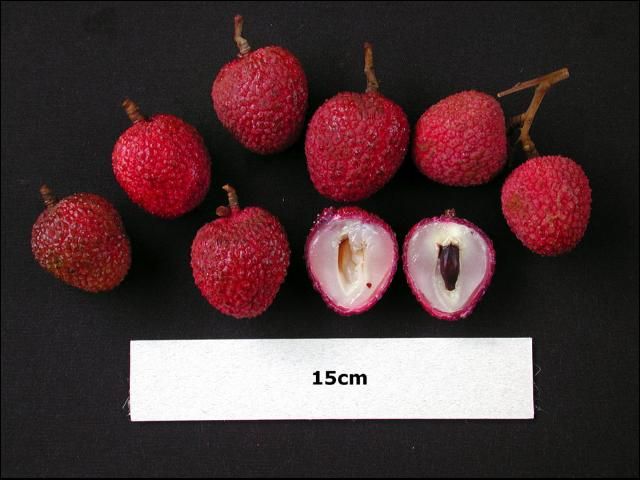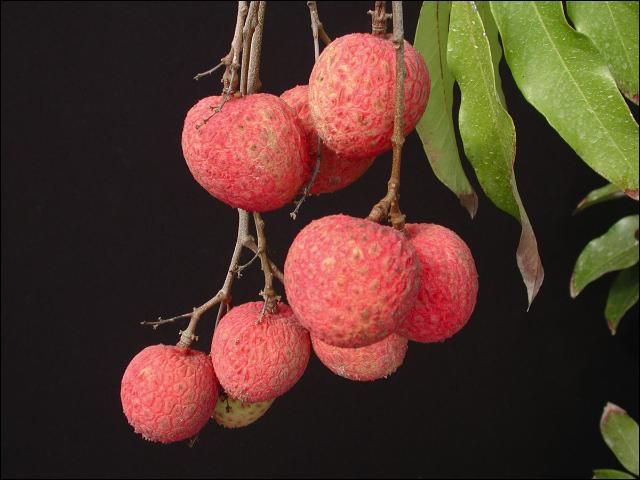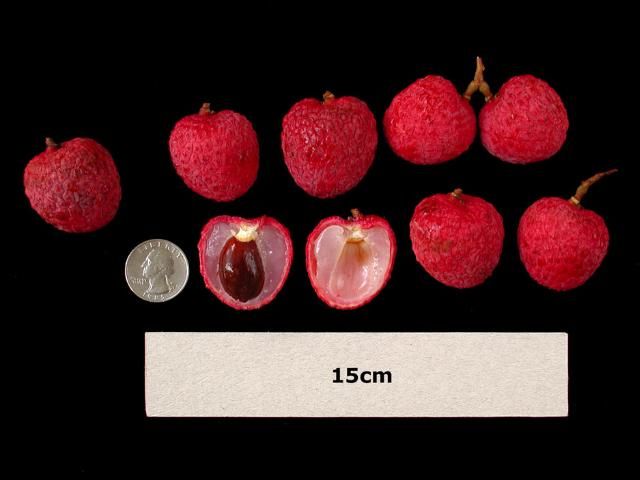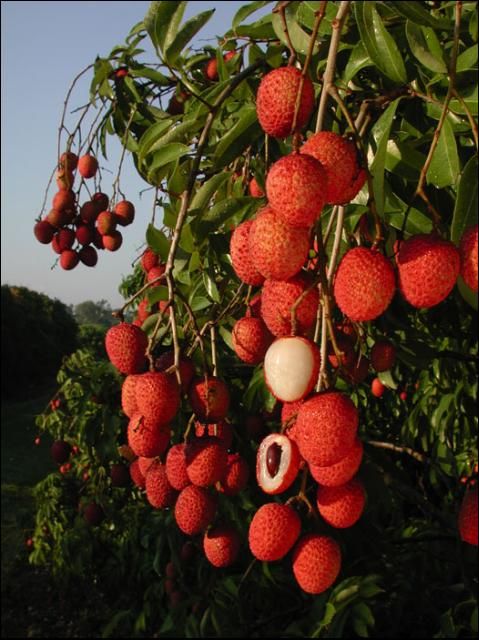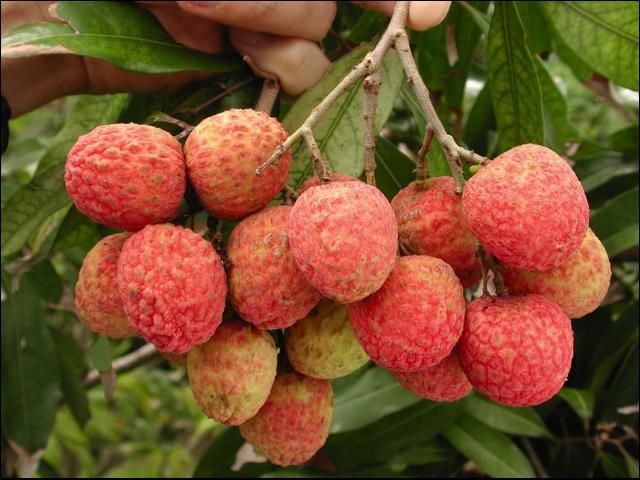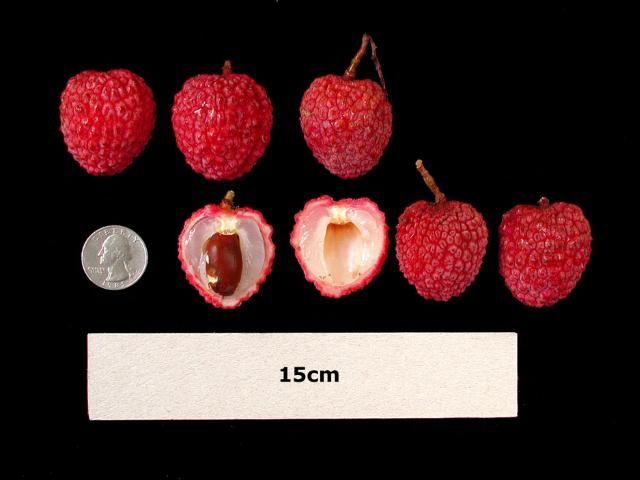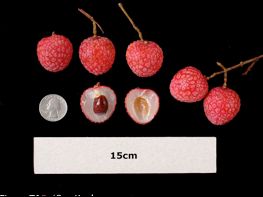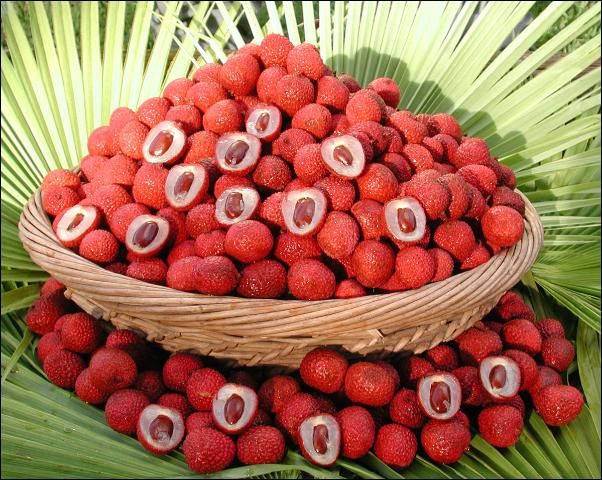
Credit: Ian Maguire, UF/IFAS TREC
Other common names: litchi, leechee, mamoncillo chino (Spanish), lichi
Scientific name: Litchi chinensis Sonn.
Family: Sapindaceae
Relatives: Spanish lime (mamoncillo, kinep; Melicoccus bijugatus), longan (Dimocarpus longan Lour.), akee (Blighia sapida Koenig.), and rambutan (Nephelium lappaceum L.)
Origin: Southern China and southeastern Asia
Distribution: Subtropical and tropical areas of the world. Reliable bearing and highest production occurs in subtropical and Mediterranean-type climates. Areas with significant altitude may also be productive.
Production: Lychee are grown commercially in many subtropical areas such as Australia, Brazil, southeast China, India, Indonesia, Israel, Madagascar, Malaysia, Mauritius, Mexico, Myanmar, Pakistan, South Africa, Taiwan, Thailand, Vietnam, and the US (Florida, Hawaii, and California).
Description
Tree
Trees may grow to 40 ft (12 m) in height and have a beautiful, dense, rounded, symmetrical canopy extending nearly to the ground (Figure 2a and 2b). Trees are very attractive with dark green foliage and reddish-colored fruit. Typically major limbs of nontrained trees begin within 3 ft (0.9 m) of the ground.
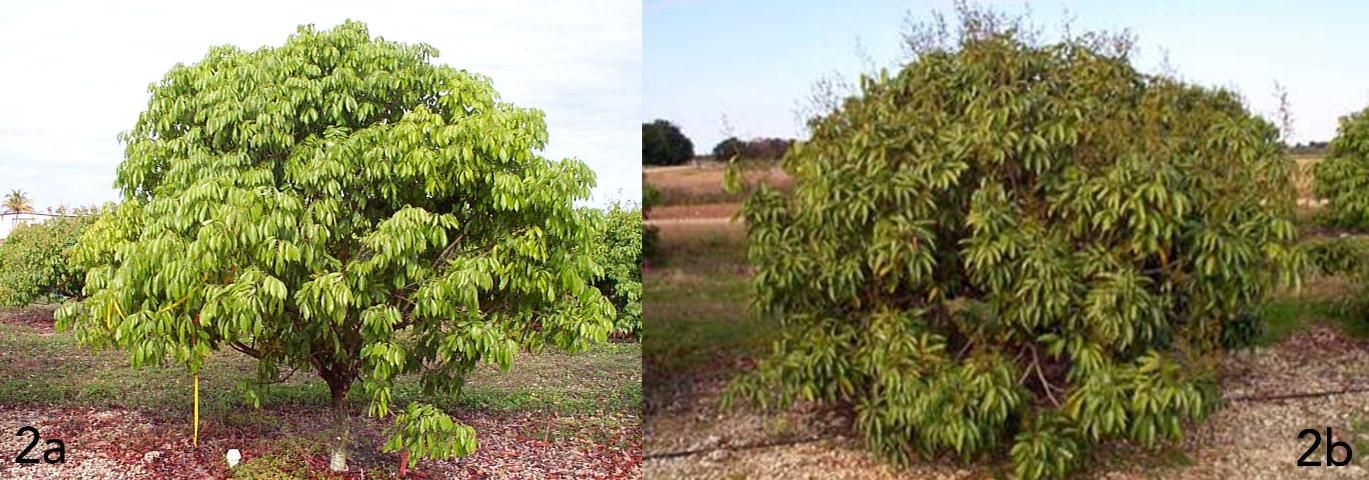
Credit: Ian Maguire, UF/IFAS TREC
Leaves
Leaves are compound with 2 to 8 leaflets. Leaves have a reddish color when young, becoming shiny and bright green when mature (Figure 3).

Credit: Ian Maguire, UF/IFAS TREC
Flowers
Flowers are small, greenish, and are borne on a large thyrse (a many-flowered inflorescence) that emerges at the ends of branches anytime from late December to April (more commonly February and March) in Florida (Figures 4a and 4b). There are three flower types: two male types (called M1 and M2) and one female (called F). In general, the M1 flowers open first, female flowers (F) open second, and M2 flowers open third.

Credit: Ian Maguire, UF/IFAS TREC
Fruit
The fruit is a drupe and fruit are borne in loose clusters numbering from 3 to 50 fruits and are round to oval and 1.0 to 1.5 inches (25 to 38 mm) in diameter (Figures 1 and 5). The skin (pericarp) ranges from yellow to pinkish or red and is leathery, with small, short, conical or rounded protuberances. The edible portion of the fruit (pulp) is called an aril that is succulent, whitish, translucent, with excellent subacid flavor. Fruits contain one shiny, dark brown seed, usually relatively large, but it may be small and shriveled (called chicken tongues) in some varieties. Fruit must be ripened on the tree for best flavor.
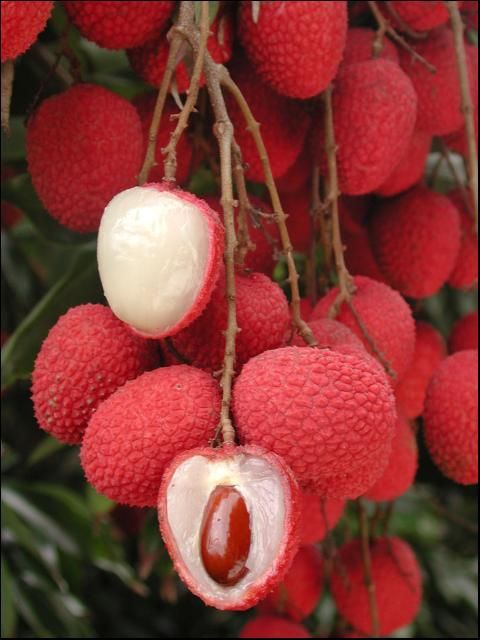
Credit: Ian Maguire, UF/IFAS TREC
Pollination
Lychee flowers are pollinated by bees and various fly species (Figure 6). Isolated or single lychee trees will usually set acceptable amounts of fruit. However, recent research has demonstrated that under some conditions, cross-pollination among different cultivars may increase fruit set. Therefore, in some cases there may be an advantage to planting more than one variety.
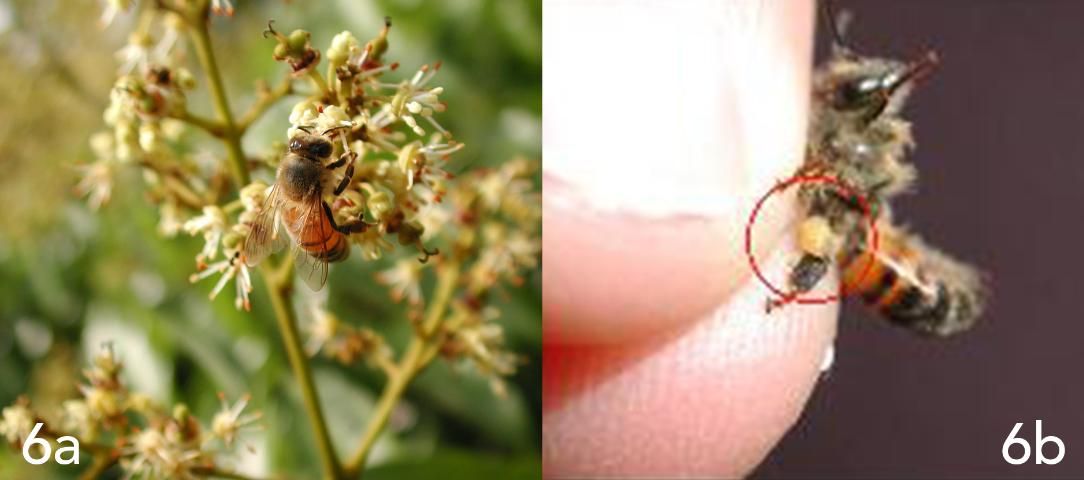
Credit: Ian Maguire, UFIFAS TREC
Season of Bearing
Mid-May to early July in Florida, depending upon variety.
Varieties
'Mauritius' is the major commercial cultivar and bears more regularly than 'Brewster,' which is the second most grown cultivar (Table 1). Some other cultivars have been evalu- ated, and new introductions are under evaluation.
Climate
Lychee does not fruit satisfactorily at sea level in tropical climates and is best adapted to warm to cool subtropical areas. The best climates for lychee production have a dry, cold (but nonfreezing) winter period lasting 3 to 5 months; a warm spring during the flowering period; a hot and humid summer during fruit growth, development, and maturation; and moderately warm temperatures during the fall. Periodic rainfall during spring and summer is ideal.
The lychee has more cold tolerance than mango but less than sweet orange, so plantings are limited to coastal areas in southern Florida (Figure 7). Young trees are damaged at temperatures of 28° to 32°F (-2° to 0°C), while temperatures down to 24° to 25°F (-3° to -4°C) cause extensive damage or death to large trees if exposed for several hours. Lychee trees do not acclimate to cold temperatures after exposure to cool, nonfreezing temperatures. Symptoms of cold damage include leaf death, leaf drop, stem and limb dieback, bark splitting, and tree death.

Credit: Ian Maguire, UF/IFAS
Water
Lychee trees are moderately drought tolerant. However, newly planted lychee trees should be irrigated regularly during establishment. In the home landscape, trees will perform well without supplemental irrigation after trees are established. For more consistent cropping of mature trees, withholding irrigation during the fall and winter until bloom may enhance the amount of flowering. Watering during fruit set through harvest may enhance fruit quality and yields.
Lychee may withstand short periods of flooding. However, their reaction to flooding is dependent upon flood duration, tree size, presence or absence of root diseases, and weather conditions. Planting trees on mounds or beds is recommended for areas prone to wet or flooded soil conditions.
Wind
Young lychee trees are sometimes difficult to establish in windy sites, and exposure to constant winds may result in tattered leaves, stunted shoot growth, and stem dieback. In the rocky soils of Miami-Dade County, the bark at the soil line of young trees may be damaged by continuous rubbing due to the movement caused by high winds. If possible, trees should be planted in wind-protected sites or protected from wind by surrounding trees with light shade cloth which has been attached to wire fencing.
Propagation
Lychee trees do not come true from seed, and seedling trees may take 10 or more years to bear fruit. Air layering is the most common method of propagation in Florida (Figure 8). In general, the larger the limb, the easier it is to air layer. Grafting (usually cleft or veneer) and budding onto lychee seedlings or air layers is possible but is not as common as air layering alone; this may change as superior rootstocks are identified. Top working is possible although not common and may become more common as superior cultivars are recommended. Air-layered or grafted trees begin to bear fruit in 3 to 5 years.

Credit: Ian Maguire UF/IFAS TREC
Seedlings may be useful as rootstocks but are not generally recommended because of genetic variability and vary in their tolerance to different soil conditions (e.g., high-pH, calcareous soil).
Production (Crop Yields)
Unreliable bearing is the major constraint to lychee production. Cultivars vary greatly in their bearing habit. Mature 'Brewster' trees (15 to 20 ft tall; 4.6 to 6.1 m tall) may bear 200 to 300 lb (91 to 136 kg) of fruit in a good year; however, most trees bear a good crop only about 1 year out of 3 or 4. In contrast, well-cared-for, mature 'Mauritius' trees may bear every year, with good yields in alternating years. On average, yields range from less than 50 lbs to 125 lbs (23–58 kg) per tree per year over a period of years.
Spacing
Planting distances depend on soil type and fertility, current technology, and expertise of the homeowner. Lychee trees in the home landscape should be planted 25 to 30 feet or more (7.6 to 9.1 m) away from buildings, other trees, and electrical wires. Trees planted too close to other trees or structures may not grow normally or produce much fruit due to shading.
Soils
Trees grow best in well-drained soils. Of the soils of southern Florida, lychee trees grow best in acid sands with moderate organic matter content. Trees grow well in the muck soils, but usually do not fruit well because of excessive vegetative (shoot and leaf) growth. Sandy soils with low organic matter content are suitable if sufficient fertilizers are supplied. Lychee may be grown on the rocky, calcareous soils of the southeast coast but require special care to prevent minor element deficiencies.
Planting a Lychee Tree
Site Selection
In general, lychee trees should be planted in full sun for best growth and fruit production. Select a part of the landscape away from other trees, buildings and structures, and power lines. Remember lychee trees can become very large if not pruned to contain their size. Select an area of the landscape that does not flood (or remain wet) after typical summer rainfall events.
Planting in Sandy Soil
Many areas in Florida have sandy soil. Remove a 3 to 10 ft (0.9–3.1 m) diameter ring of grass sod. Dig a hole 3 to 4 times the diameter and 3 times a deep as the container the lychee tree came in. Making a large hole loosens the soil adjacent to the new tree, making it easy for the roots to expand into the adjacent soil. It is not necessary to apply fertilizer, topsoil, or compost to the hole. In fact, placing topsoil or compost in the hole first and then planting on top of it is not desirable. If you wish to add topsoil or compost to the native soil, mix it with the soil excavated from making the hole in no more than a 1:1 ratio.
Backfill the hole with some of the native soil removed to make the hole. Remove the tree from the container and place it in the hole so that the top of the soil media in the container is level with or slightly above the surrounding soil level. Fill soil in around the tree roots and tamp slightly to remove air pockets. Immediately water the soil around the tree and tree roots. Staking the tree with a wooden or bamboo stake is optional. However, do not use wire or nylon rope to tie the tree to the stake as they may eventually damage the tree trunk as it grows. Use a cotton or natural fiber string that will degrade slowly.
Planting in Rockland Soil
Many areas in Miami-Dade County have a very shallow soil and several inches below the soil surface is a hard calcareous bedrock. Remove a 3 to 10 ft (0.9–3.1 m) diameter ring of grass sod. Make a hole 3 to 4 times the diameter and 3 times a deep as the container the lychee tree has come in. To dig a hole there are several options use a pick and digging bar to break up the rock or contract with a company that has augering equipment or a backhoe. Plant the tree as described in the previous section.
Planting on a Mound
Many areas in Florida are within 7 ft (2.1 m) or so of the water table and experience occasional flooding after heavy rainfall events. To improve plant survival, consider planting fruit trees on a 2 to 3 ft (0.6–0.9 m) high by 4 to 10 ft (1.2–3.1 m) diameter mound of native soil.
In areas where the bedrock nearly comes to the surface (rockland soil) follow the recommendations for the previous section. In areas with sandy soil follow the recommendations from the section on planting in sandy soil.
Care of Lychee Trees in the Home Landscape
A calendar outlining the month-to-month cultural practices for lychee is shown in Table 2.
Fertilizer
Young trees (less than 4 years old) should be fertilized with 0.25 to 0.50 lbs (0.11 to 0.22 kg) of a complete fertilizer every 8 weeks (Table 3). Fertilizer mixtures containing 6 to 8% nitrogen, 2 to 4% available phosphorus, 6 to 8% potash, and 3 to 4% magnesium are satisfactory. Twenty to 50% of the nitrogen should be in organic form.
In acid to neutral-pH soils, micronutrients such as manganese, zinc, and iron may be applied in dry applications to the soil. However, foliar applications of manganese and zinc should be made to trees growing in high-pH, calcareous soils.Two to four applications of micronutrients should be made during the growing season (March to November).
Soil applications of iron sulfate may be effective in acid to neutral-pH soils. However, in high-pH, calcareous soils, chelated (Fe-EDDHA) iron in a soil drench should be applied. For young trees, mix 0.5 to 2.0 ounces (14 to 57 g) of iron chelate in sufficient water to move the material into the soil around the base of the tree. For mature trees mix 0.5 to 4.0 ounces (14 to 113 g) of iron chelate per tree per application. Iron should be applied 2 to 4 times during the growing season.
Once trees are 4 or more years old and begin fruit production, applications of nitrogen containing fertilizer from August until early spring (February–March) should be avoided. Nitrogen applications during this time may stimulate new vegetative growth (i.e., leaves and shoots) and reduce or eliminated the potential for flowering and fruit production.
Irrigation (Watering)
Young trees should be irrigated regularly to facilitate tree establishment and growth. Once trees begin to bear (3 to 4 years after planting), trees should be irrigated regularly from flowering through harvest. Research from other regions has suggested that mild drought stress during the fall (September or October) and early winter enhances flowering in late winter or early spring.
Insect Pests
The panicles (thyrses) and flowers of lychee are attacked by a number of moth pests. Periodically, plumose (Morganela longispina) and Philephedra tuberculosa scales attack stems, and heavy infestations may cause stem dieback. Adult Diaprepes root weevils (Diaprepes abbreviatus) and citrus root weevils (Pachnaeus litus) feed on lychee leaves, and their larvae feed on the roots of lychee trees causing a loss of tree vigor. Several nematode species (reniform, Rotylenchulus reniformis; and sheath nematode, Hemicriconemoides mangiferae) cause decline of young lychee trees.
Diseases
Anthracnose (Colletotrichum gloeosporioides ) is the major disease attacking fruit. The fruit of some cultivars (e.g., 'Mauritius') are much more susceptible than others (e.g., 'Brewster'). Occasionally, mushroom root rot (Clitocybe tabescens) kills lychee trees, often in land where oaks (Quercus virginiana) were previously grown. A parasitic lichen may occasionally attack leaves. Red algae may attack lychee shoots and limbs; symptoms include grayish to rust-colored, irregularly-shaped patches on the bark and bark splitting. For more information and control measures, consult your local UF/IFAS Extension agricultural agent.
Lychee Trees and Lawn Care
Lychee trees in the home landscape are susceptible to trunk injury caused by lawn mowers and weed eaters. Maintain a grass-free area 2 to 5 or more feet away from the trunk of the tree. Never hit the tree trunk with lawn mowing equipment and never use a weed eater near the tree trunk. Mechanical damage to the trunk of the tree will result in weakening the tree and if severe enough can cause the tree to dieback or die.
Roots of mature lychee trees spread beyond the drip-line of the tree canopy and heavy fertilization of the lawn adjacent to lychee trees is not recommended and may reduce fruiting and or fruit quality. The use of lawn sprinkler systems on a timer may result in over watering and cause lychee trees to decline. This is because too much water, too often is being applied, which results in root rot.
Mulch and Compost
Applying a thin layer of well cured compost from the drip-line to within 6 inches of the trunk may be beneficial for the fibrous roots of lychee trees. In addition, mulching lychee trees in the home landscape helps retain soil moisture, reduces weed problems adjacent to the tree trunk, and improves the soil near the surface. Mulch with a 2 to 6 inch (5–15 cm) layer of bark, wood chips, or similar mulch material. Keep mulch 8 to 12 inches (20–30 cm) from the trunk to prevent rotting of the base of the trunk.
Pruning
Generally, training of young trees is not required. However, formative pruning during the first 2 years may be desirable to encourage lateral branching and growth. After several years of production it is desirable to cut back the tops of the trees to 10 to 15 feet (3.0 to 4.6 m). Selectively removing a few upper limbs back to their origin (crotches) each year will help prevent the loss of the lower tree canopy due to shading by the upper canopy. In addition, maintaining a smaller tree facilitates tree care and fruit harvest, makes it easier to spray the tree, and greatly reduces possible storm damage. Do not remove lower tree branches because they will help shade beneath the tree canopy and reduce weed growth and these branches may flower and fruit.
Pruning should be carried out immediately after harvest to allow regrowth and maturation of new shoots and leaves before the onset of cool/cold winter temperatures. Severe pruning is sometimes used to reduce tree height or width of very large trees. It does not injure lychee trees, but reduces fruit production for one to several seasons. Once lychee trees become 30 ft (9.1 m) or taller extreme caution should be used in pruning the trees. Climbing trees to prune them is dangerous and not recommended. Pruning of large lychee trees should be done by a professional arborist that is licensed and insured.
Harvesting
Fruit are harvested by cutting the main stem bearing the fruit clusters several inches behind the fruit clusters (Figure 9). Fruit may or may not be detached from the fruit clusters before storage. Ripe fruit are sweet, plump, and of the size and color characteristic of the cultivar (Table 1). Fruit picked while immature are not sweet and have poor flavor.
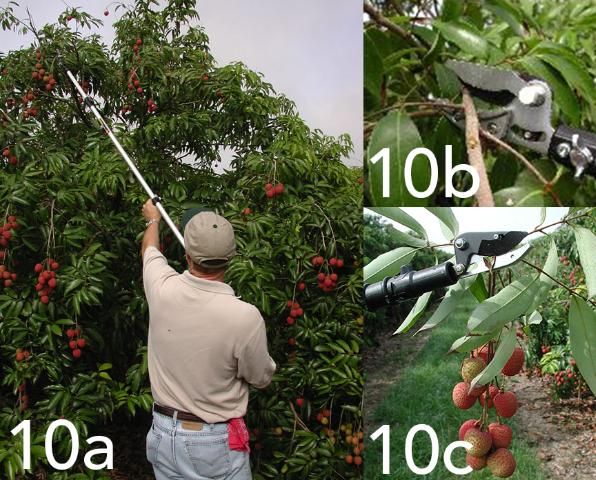
Credit: Ian Maguire, UFIFAS TREC
Uses and Nutritional Value
Lychee are an excellent fresh fruit and are best consumed as soon after harvest as possible. The fruit are low in calories and a good source of potassium, and are commonly eaten out of hand (Table 4). Fresh fruit may be stored in polyethylene bags in the refrigerator for 5 to 10 days and retain reasonable color and freshness. Fruit may be frozen whole (in the peel), canned (without the peel), and dried (in the peel) for later use. In the home landscape, lychee make beautiful specimen trees that provide fruit, aesthetics, and shade.
